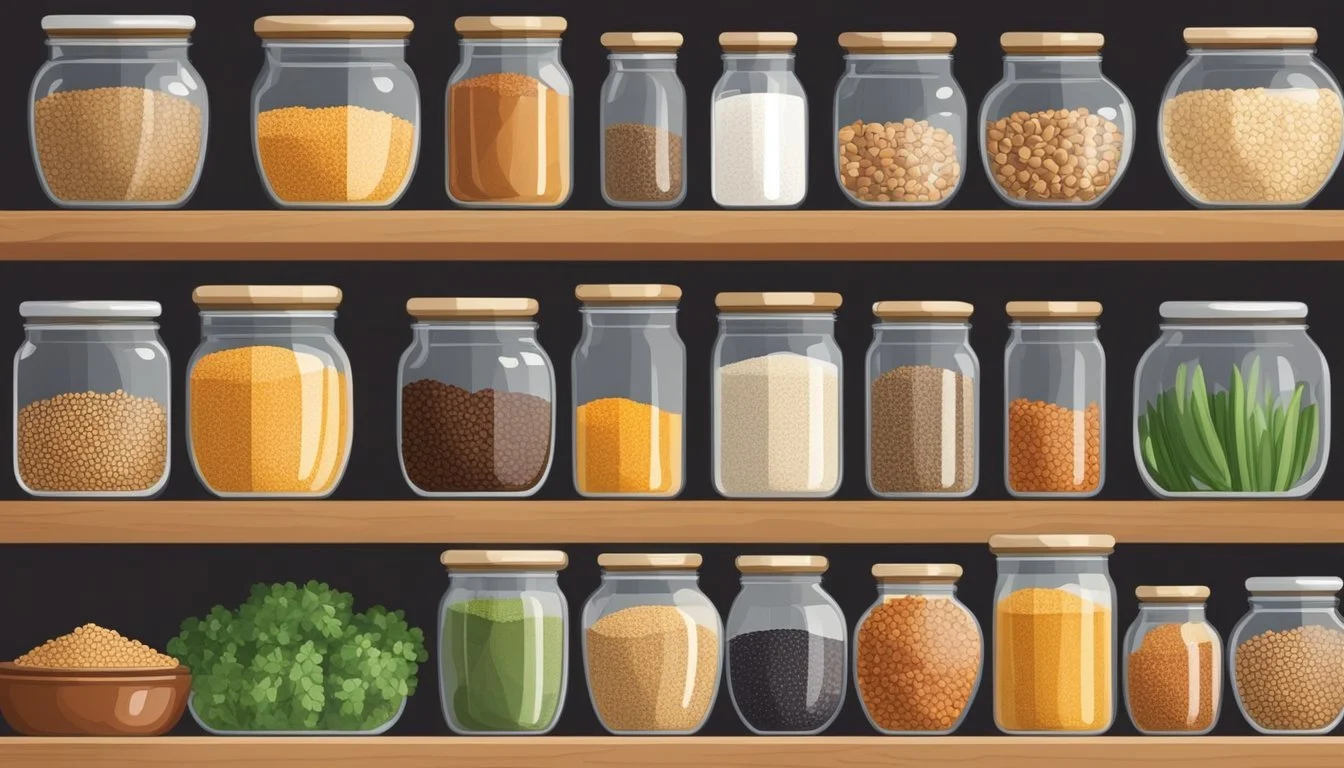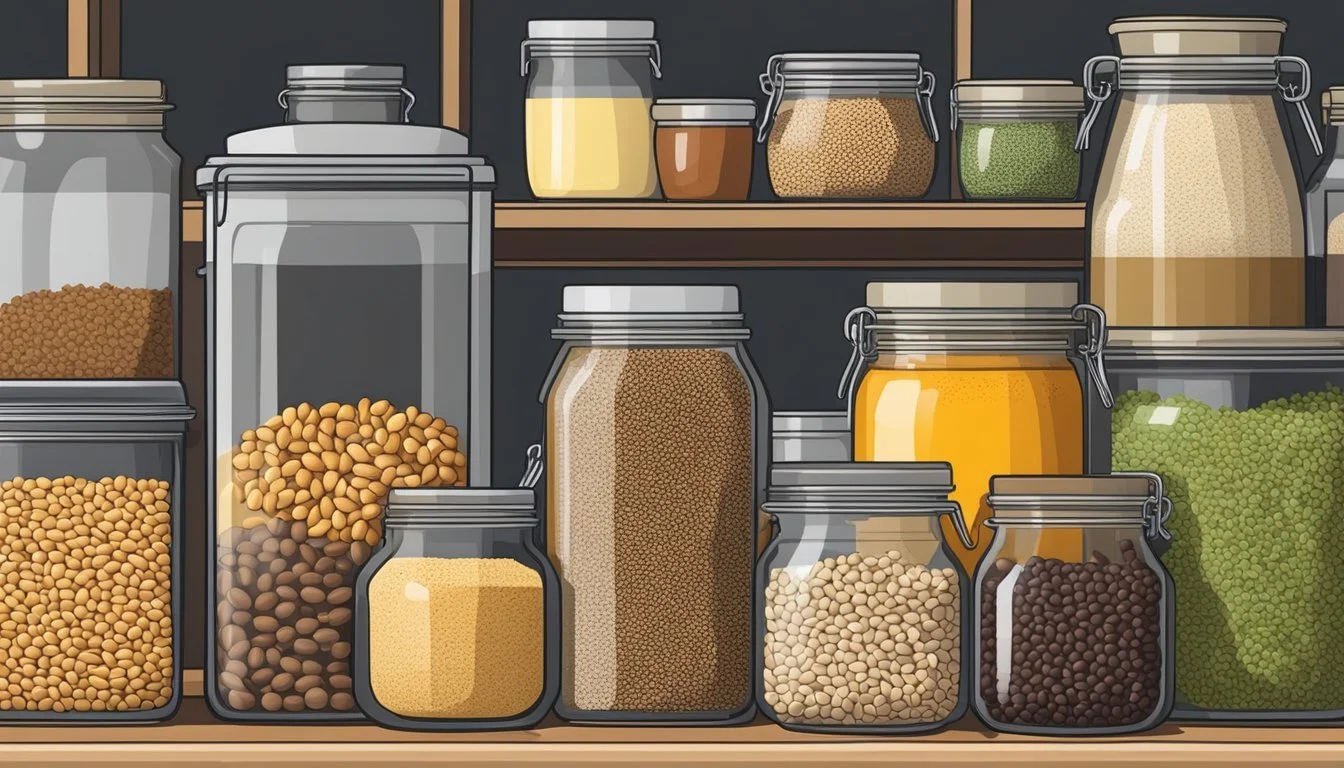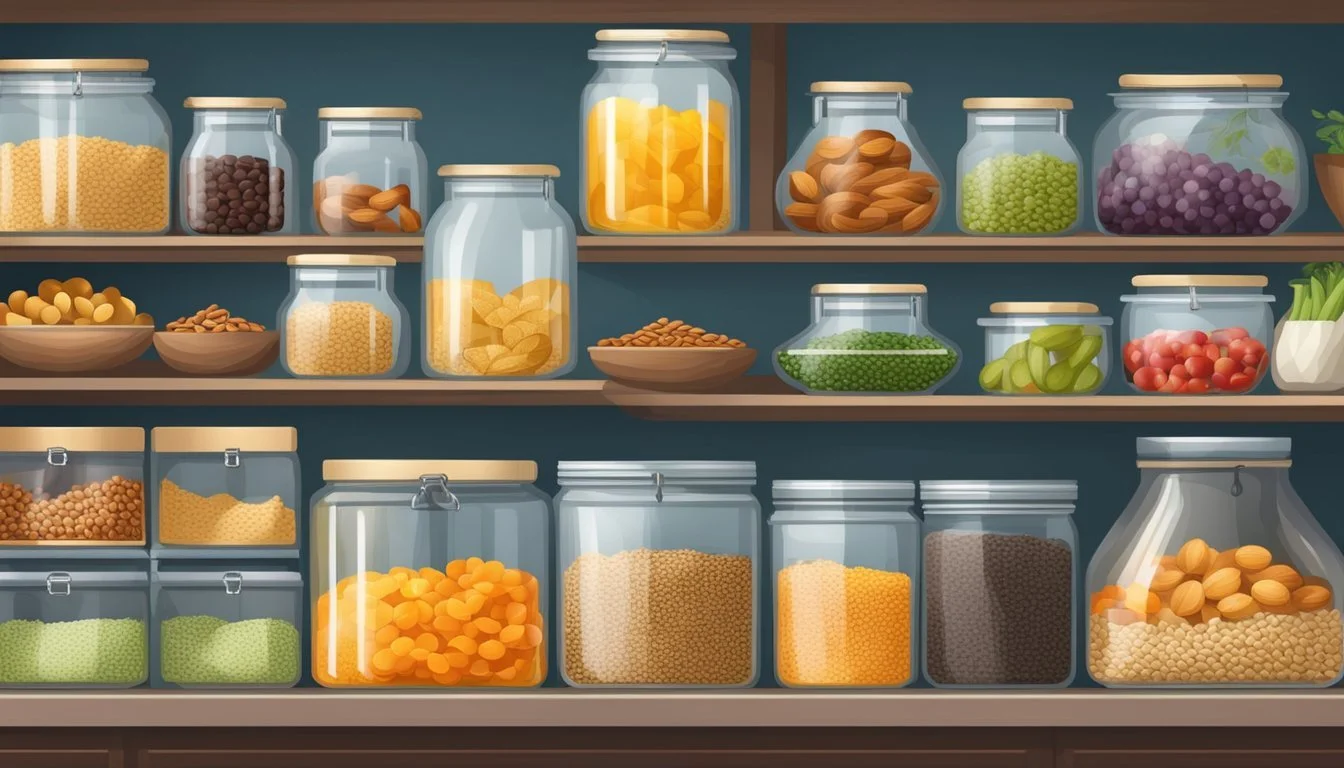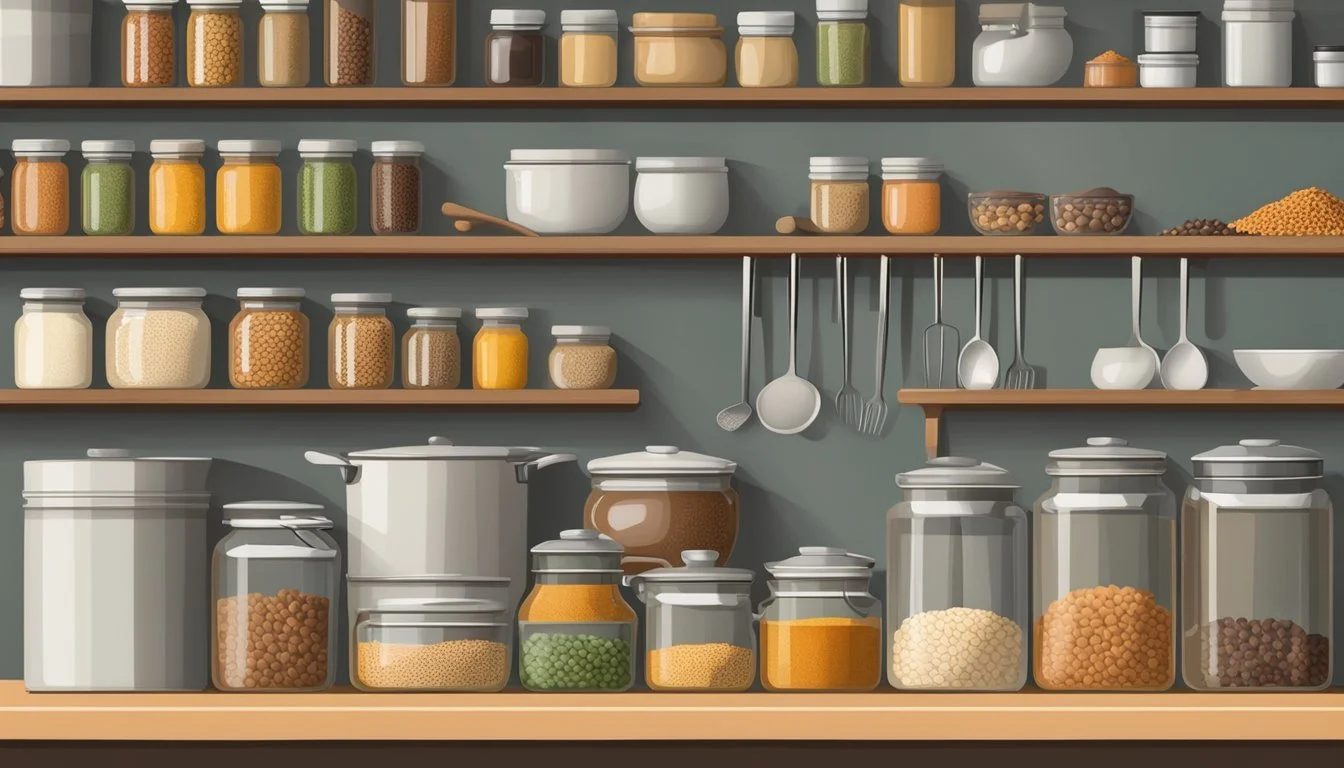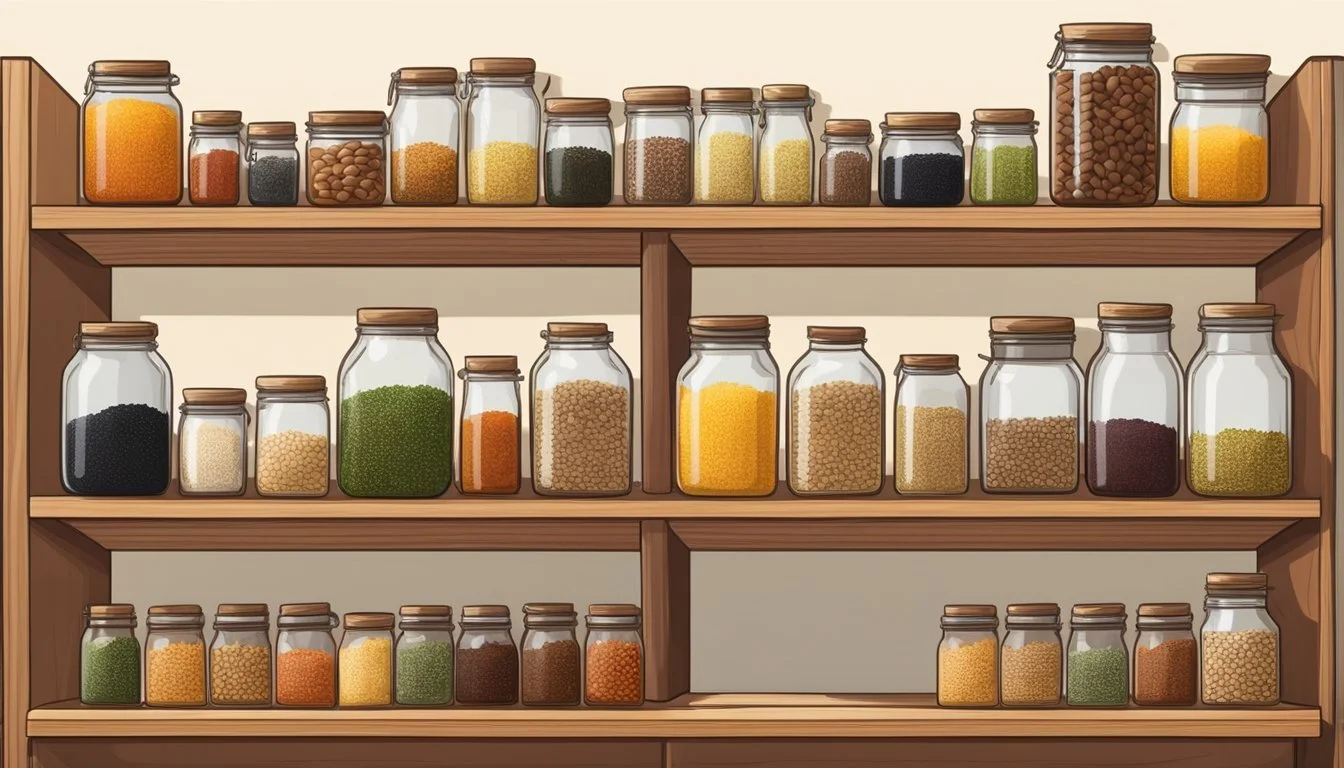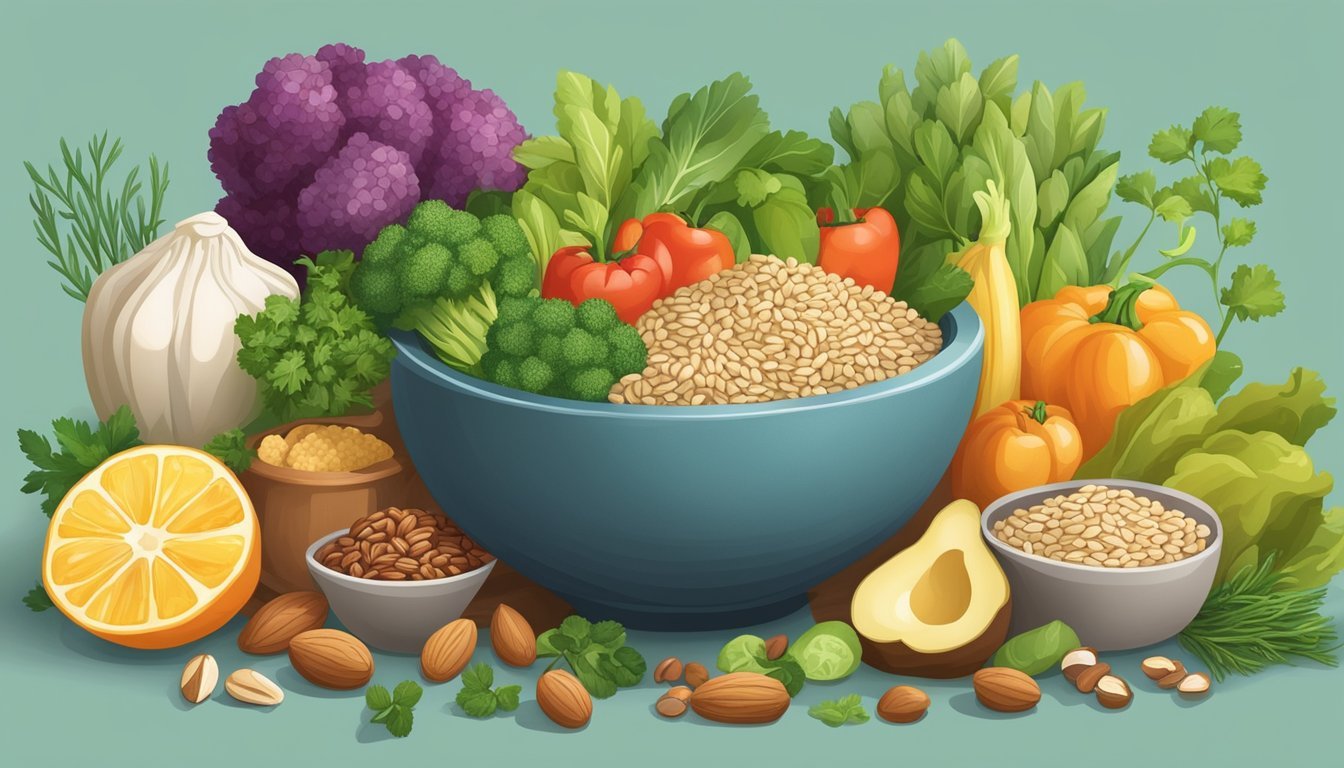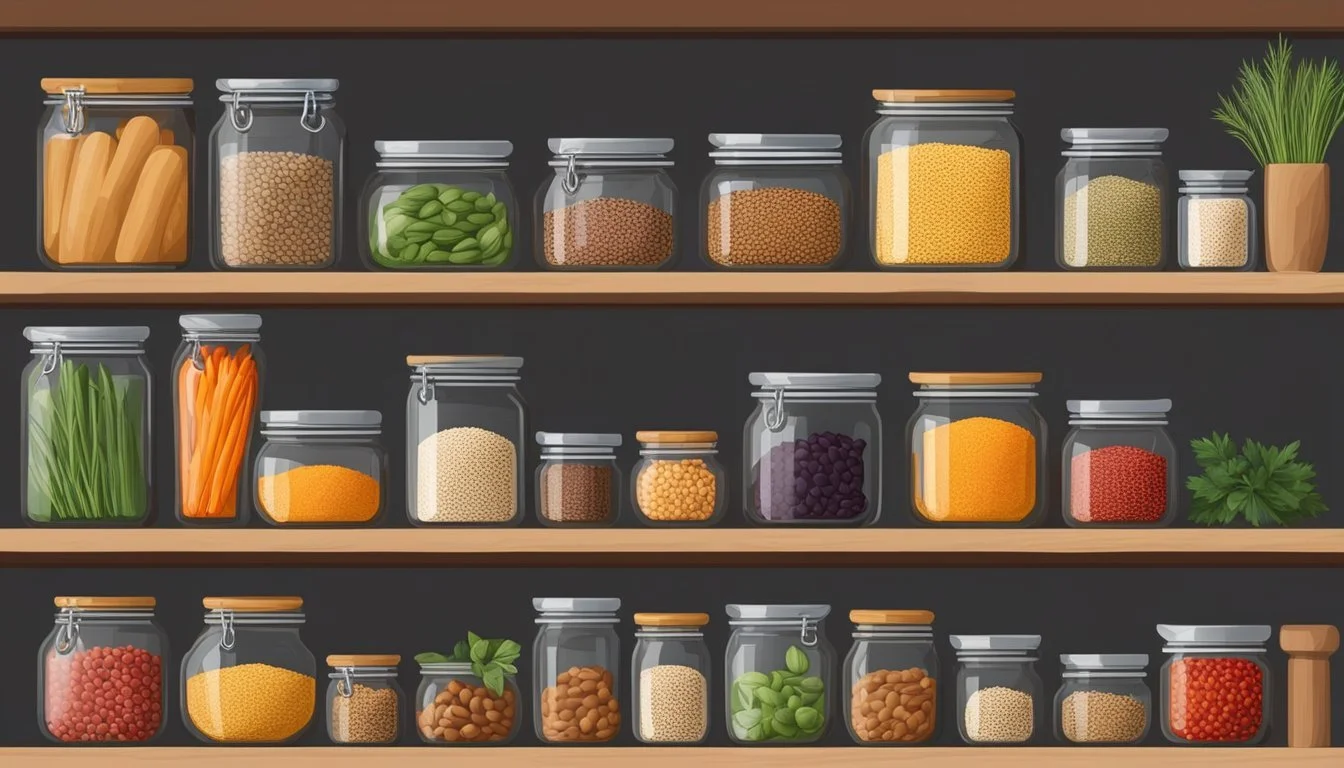Pantry-Based Grain Bowls
Quick, Nutritious Meal Ideas
Grain bowls epitomize the intersection of health and convenience, making them a favored meal for those seeking both nutrition and simplicity. Pantry-based grain bowls, in particular, capitalize on the use of non-perishable items readily available in one's pantry, which can include grains such as quinoa, farro, or rice, along with a variety of canned beans, lentils, and dried spices. These bowls are a testament to the versatility and ease with which one can assemble a wholesome meal with minimal effort.
Using a base of hearty grains, pantry-based grain bowls can be customized to cater to individual tastes and dietary preferences. The incorporation of various textures and flavors from ingredients like roasted vegetables, spices, and dressings adds layers of complexity to the dish. Nutrient-packed toppings such as nuts, seeds, and dried fruits (What wine goes well with dried fruits?) contribute both to the nutritional profile and to the variety of each bite.
Easy to prepare and adaptable to what's on hand, these bowls serve as a canvas for creativity in the kitchen. They allow home cooks to effortlessly combine different food groups to achieve a balance of macronutrients in their diet. It's this seamless integration of healthful ingredients that positions pantry-based grain bowls not just as a trend, but as a sustainable staple in the landscape of modern, everyday cuisine.
Essential Pantry Staples for Grain Bowls
Creating a nutritious and satisfying grain bowl starts with a well-stocked pantry. Including a variety of grains, legumes, nuts, and seasonings ensures a balance of textures, flavors, and essential nutrients.
Choosing Whole Grains
Whole grains are the foundation of any grain bowl, offering a combination of fiber, vitamins, and sustained energy. Staple grains include:
Rice: A versatile base with varieties like jasmine, basmati, and short-grain sushi rice.
Quinoa: A protein-rich pseudo-grain, perfect for adding a nutty flavor.
Brown Rice: Offers more fiber and nutrients than white rice due to its intact bran layer.
Farro: An ancient grain with a chewy texture and a rich, nutty taste.
Legumes and Beans
Legumes and beans are essential sources of plant-based protein and fiber, which contribute to the heartiness of grain bowls. Key legumes to keep on hand:
Lentils: Quick to cook and available in various colors, lentils are high in protein.
Chickpeas: Ideal for adding texture, and can be used roasted or cooked.
Black Beans: A staple in many cuisines, black beans are versatile and nutritious.
Kidney Beans: Large, reddish beans that are a great source of iron.
White Beans: Such as cannellini or navy beans, they offer a creamy texture and a mild flavor.
Nuts and Seeds
Nuts and seeds add crunch, healthy fats, and additional protein to grain bowls. They can be sprinkled on top for a finishing touch.
Cashews: Mild and buttery, they work well in both savory and sweet applications.
Seeds: Such as sunflower or pumpkin seeds, enhance the fiber content and offer a satisfying crunch.
Herbs and Spices
Herbs and spices are the secret to transforming simple ingredients into a culinary experience.
Cilantro: Adds a fresh, citrusy note to brighten up grain bowls.
Black Pepper: A must-have for its pungent, earthy heat.
Ginger: Lends a warm, spicy kick to many dishes.
Keeping these staples readily available makes assembling a nutritious and flavorful grain bowl easy and allows for endless customization to cater to personal tastes or dietary needs.
Fresh and Frozen Ingredients
When constructing pantry-based grain bowls, fresh and frozen ingredients add essential flavors, textures, and nutrients. They allow for variety and can enhance the meal with minimal preparation.
Vegetables and Greens
Fresh Veggies: For a nutritious foundation, fresh vegetables like spinach, onions, garlic, and mushrooms are convenient to chop and include. Spinach provides a tender leafy base while onions and garlic offer pungent accents that can be sautéed to mellow their bite. Mushrooms, with their umami richness, can be quickly pan-fried or roasted.
Spinach: Excellent raw or just wilted
Onions/Garlic: Best when sautéed lightly
Mushrooms: Versatile, can be used raw or cooked
Frozen Vegetables: Freezers should be stocked with frozen varieties like mixed vegetables – they maintain their nutritional value and are ready at a moment's notice. They require minimal cooking time and ensure that a grain bowl has a serving of greens even when the fridge is empty.
Mixed Veggies: Just steam or microwave
Fruits and Berries
Apples: Fresh apples can be diced for a crisp, sweet contrast in grain bowls. They pair especially well with grains like farro or quinoa and add a burst of freshness.
Berries: Berries serve as a sweet and tart component. If using frozen berries, they can be thawed slightly before adding to a bowl. Blueberries, in particular, offer a pop of flavor and color, and are rich in antioxidants.
Fresh Apples: Dice for added crunch
Frozen Berries: Thaw for sweetness and to cool the dish
Refrigerated Essentials
Dairy: Items like Greek yogurt and butter can be used as creamy elements or to construct dressings. Yogurt adds a tangy contrast to the savory components, and butter can be used to sauté vegetables for added richness.
Greek Yogurt: Stir in for creaminess
Butter: Use for cooking vegetables
Eggs: A fridge staple, eggs are a reliable source of protein. They can be prepared in various ways – boiled, poached, or fried – and incorporated as a hearty topping for grain bowls.
Eggs: Offer a versatile protein choice
By utilizing both fridge and freezer staples such as spinach, onions, garlic, mushrooms, and berries, one can enhance the nutritional profile and taste of their grain bowl, ensuring a fulfilling and balanced meal.
Protein Sources for Grain Bowls
Choosing the right protein source can transform a grain bowl from an ordinary meal to a nutrient-dense powerhouse. It is crucial to pair grains with high-quality proteins to ensure a well-rounded and satisfying dish.
Animal-Based Proteins
When considering animal-based proteins, options like tuna (What wine goes well with tuna?) and salmon are excellent for adding omega-3 fatty acids and lean protein to grain bowls. They not only contribute to the dish's overall health benefits but also bring a distinct flavor.
Tuna: either fresh or canned, it provides a heart-healthy addition
Salmon: offers a rich texture and can be baked, grilled, or flaked
Eggs: hard-boiled or poached, they are a versatile protein choice
Chicken: often used shredded or diced for ease of eating
Eggs serve as a more cost-effective option and can be prepared in various ways, such as hard-boiled, soft-boiled, or poached, to suit individual preferences.
Animal-Based Protein Preparation Method Tuna Fresh, grilled, or canned Salmon Baked, grilled, or flaked Eggs Hard-boiled, poached, or fried Chicken Shredded, grilled, or diced
Plant-Based Proteins
For vegetarians, vegans, or those simply looking to include more plant-based options in their diet, proteins such as tofu, tempeh, and beans are excellent choices. They are not only rich in protein but also provide essential amino acids, fiber, and various vitamins and minerals.
Tofu: known for its versatility and ability to absorb flavors
Tempeh: offers a firmer texture and nuttier flavor than tofu
Beans: include a myriad such as black beans, chickpeas, or lentils
Each of these can be seasoned and prepared to complement the flavors of the grain bowl.
Plant-Based Protein Characteristics Tofu Absorbs flavors, soft or firm options Tempeh Firm texture, nutty flavor Beans Variety of choices, fiber-rich
Building the Base: Grains and Flavors
When constructing a grain bowl, the foundation sets the stage for flavor and nutrition. A versatile array of grains can be employed, each bringing its unique texture and taste profile. Rice is a popular choice for its neutral palate and ability to absorb flavors well. Whether brown rice for its nutty undertones and whole-grain benefits or white rice for a softer, more subtle taste, it complements an array of ingredients.
Another grain star is quinoa, touted for its high protein content and delicate, slightly earthy taste. It's a gluten-free option that pairs flawlessly with vegetables and dressings in salads. Here's how to prepare these grains for maximum flavor:
Grain Preparation Brown Rice Rinse thoroughly, then cook with a pinch of salt until tender. White Rice Simmer with a 1:2 ratio of rice to water until fluffy and soft. Quinoa Rinse to remove saponins, then cook with a 1:2 ratio of quinoa to water.
In terms of flavors, one cannot underestimate the power of olive oil. Its use in grain bowls enhances richness and provides a smooth mouthfeel. Incorporating a tablespoon or two into the cooking process for grains, or drizzling over the completed bowl, adds a heart-healthy source of fat and subtly piquant flavor.
By carefully selecting and preparing grains, and skillfully integrating flavors like those of quality olive oil, one creates a gratifying base for the grain bowl. From here, the addition of proteins, vegetables, and dressings will complete the journey to a satisfying and healthful meal.
Customizing Your Grain Bowl
Crafting a grain bowl is an art that marries simplicity with endless variety. It affords the perfect canvas to turn basic pantry items into nourishing comfort food that can range from a quick snack to a comprehensive meal.
Mix and Match Toppings
The beauty of grain bowls lies in the versatility of toppings. For a satisfying crunch, one can sprinkle a mix of nuts like almonds or walnuts and seeds such as chia or pumpkin seeds. Veggies can be either raw for a fresh texture or roasted to enhance their sweetness and depth of flavor. Incorporating avocado adds a creamy component that complements both the nutty grains and the varied textures of the other toppings.
Examples of Toppings:
Fresh veggies: sliced bell peppers, shredded carrots
Roasted veggies: sweet potatoes, broccoli, Brussels sprouts
Nuts: almonds, cashews
Seeds: sunflower seeds, flax seeds
Legumes: chickpeas, black beans
Protein: grilled chicken, tofu
Sauces and Dressings
A grain bowl transforms from basic to brilliant with the right sauce or dressing. Simple ingredients like apple cider vinegar and tamari serve as the base for a multitude of flavors. An aficionado might whisk together a zesty vinaigrette or craft a creamy dressing with hummus or tahini. These sauces do not merely add moisture; they are essential for tying together the diverse flavors present in a bowl.
Simple Dressing Recipe:
3 tbsp olive oil
1 tbsp apple cider vinegar
1 tsp tamari
1 garlic clove, minced
Creative Combinations
The true delight in grain bowls is the freedom to explore creative combinations. One could draw inspiration from Mexican cuisine with elements like tacos, nachos, and enchiladas, utilizing spices and toppings associated with these dishes. Alternatively, a Mediterranean twist might feature a dollop of hummus, Kalamata olives, and a sprinkle of feta cheese. The goal is to experiment with recipes and flavors, turning the humble grain bowl into an adventurous and delectable eating experience.
Inspired Grain Bowl Ideas:
Mexican: quinoa, black beans, corn, avocado, cilantro-lime dressing
Mediterranean: farro, chickpeas, roasted red peppers, hummus, Greek vinaigrette
Pantry Organization and Management
A well-organized pantry stays at the heart of creating wholesome grain bowls with ease. Stocking up on a variety of grains and legumes provides an adaptable foundation for these dishes.
In organizing a pantry or cupboard for effective use, the first step is categorizing items. Essential pantry items for grain bowls may include:
Grains: barley, brown rice, farro, quinoa
Legumes: lentils, chickpeas, black beans
Seeds/Nuts: chia seeds, almonds, walnuts
Vegetables: onions, garlic, jarred roasted peppers
Condiments: olive oil, vinegars, soy sauce, tahini
An organized pantry allows for efficient meal preparation after a trip to the grocery store. To keep track, use the following table as an inventory checklist:
Grains & Legumes On Hand Need to Buy Barley ✓ Brown Rice ✓ Lentils ✓ Chickpeas ✓
Containers play a crucial role. Clear, airtight containers not only maintain freshness but also offer an immediate visual inventory. Labeling these containers with purchase or expiration dates ensures the use of older items first.
A neatly arranged pantry with groupings of similar items helps identify when to restock. Shelves should have frequently used items at the front, while bulk or lesser-used items can be stored higher up.
For long-term management, they should periodically review the pantry's contents, tossing expired items and noting what needs replenishment before the next visit to the grocery store. This discipline prevents over-buying and ensures the rotation of stock, keeping pantry staples for grain bowls fresh and ready to use.
Recipe Ideas and Inspiration
Grain bowls provide a versatile canvas for a variety of pantry-based dishes. They can easily transform into soups and stews, hearty salads, or capture the essence of global cuisines with simple modifications.
Soups and Stews
Soups and stews serve as warm, comforting options that pair grains with rich broths. A classic tomato soup can be elevated with cooked quinoa stirred in, adding a boost of protein and texture. Lentil soup becomes a meal in itself with a handful of barley or farro simmering in the savory broth, enhancing its heartiness.
Hearty Salads
Salads offer a lighter counterpoint to soups and stews, yet they can be just as satisfying. For a nutritious grain bowl salad, one can mix cooked grains like brown rice with fresh veggies—think spinach, cucumbers, and cherry tomatoes. Add a protein component like chickpeas or black beans for additional substance, and dress with a zesty lemon vinaigrette for flavor.
Global-Inspired Dishes
Distinctively flavored global dishes such as tacos, enchiladas, and nachos can be reimagined as grain bowls. Use tortilla strips for crunch, and integrate rice or quinoa as the base. For Asian influences, one might combine jasmine rice with stir-fried vegetables and tofu, drizzled with soy sauce or teriyaki. Pastas or noodles can also be swapped out for grains to create Italian or Southeast Asian bowl variations, maintaining simplicity without sacrificing the health factor.
Cooking Techniques and Tips
Crafting the perfect pantry-based grain bowl relies on mastering cooking techniques for grains and vegetables. These tips ensure that the base of the bowl is flavorful and that the vegetables complement the grains effectively.
Grain Cooking Methods
Rice: To achieve fluffy, distinct grains, use a 2:1 water-to-rice ratio for white rice and a 2.5:1 ratio for brown rice. Bring the water to a boil, add the rice, then reduce to a simmer and cover. White rice typically cooks within 18-20 minutes, while brown rice can take up to 45 minutes. Let it rest off the heat for a few minutes before fluffing with a fork.
Quinoa: Rinse quinoa under cold water to remove its natural coating, saponin, which can taste bitter. Cook it with a 2:1 water-to-quinoa ratio for about 15-20 minutes or until the germ separates from the seed, creating a translucent appearance and a ring around each grain.
Pasta: For pasta grain bowls, cook the pasta al dente in plenty of boiling salted water. Follow the package's instructions for timing, ensuring it's firm to the bite. Drain and rinse under cold water to stop the cooking process if it's not being served hot.
Prepping Vegetables
Onions and Garlic: Sauté onions and garlic as the foundation for your grain bowl. They should be diced evenly and cooked on a medium heat until the onions are translucent and the garlic is fragrant, which enhances the overall flavor profile.
Tomatoes: To prepare tomatoes, roasting is an excellent method to concentrate their flavor and add a hint of smokiness. Dice the tomatoes and toss them with olive oil, salt, and pepper. Roast in a preheated oven at 375°F (190°C) for roughly 20-25 minutes until they are caramelized around the edges.
Baking Vegetables:
Cauliflower
Brussel sprouts
Broccolini
The above vegetables benefit from baking to bring out their natural sweetness and develop a satisfying texture. Toss them in olive oil, salt, and desired seasonings, then bake at 425°F (220°C) until golden brown and tender, approximately 20-30 minutes depending on the vegetable and cut size.
Storing and Preserving Ingredients
Proper storage of ingredients is crucial for maintaining the freshness and flavor of pantry-based grain bowls. Different components require specific conditions to ensure longevity and prevent spoilage.
Grains: Store uncooked grains such as quinoa, farro, and rice in airtight containers. Keeping them in a cool, dry pantry can preserve their quality. Cooked grains can last in the fridge for 3-4 days and in the freezer for up to a month.
Legumes: Canned or dried chickpeas and lentils should be stored in the pantry. After opening or cooking, place them in the refrigerator, where they remain good for up to a week. They can be frozen for longer periods.
Vegetables: Fresh vegetables are best kept in the refrigerator's crisper drawer. For meal prep, roasted vegetables can be refrigerated for 4 days. Some veggies, like onions or radishes, can be pickled, extending their shelf life significantly.
Ingredient Pantry Fridge Freezer Uncooked Grains Airtight Cooked Grains 3-4 days 1 month Dried Legumes Airtight Cooked Legumes 1 week Longer Fresh Veggies Crisper Roasted Veggies 4 days Pickled Veggies Longer
Dressings and Sauces: Refrigerate homemade dressings in sealed containers. Before use, ensure dressings like tahini or vinaigrettes are well-shaken as separation may occur over time.
Preserved Items: Items like pesto, tahini, or preserved lemons can be stored in airtight jars in the fridge. This maintains their taste and extends their shelf life.
Tips for Refrigeration: To avoid moisture build-up, which can lead to spoilage, store food in containers with a secure lid. Regularly checking the temperatures of the fridge and freezer ensures that foods are stored at the correct temperatures.
Health Benefits of Grain Bowls
Grain bowls are treasure troves of nutrition, offering a customizable balance of whole grains, proteins, and vegetables. They cater to various dietary needs, providing substantial health benefits.
Nutritional Components
Whole Grains: The foundation of every grain bowl, whole grains, contribute significantly to dietary fiber and B vitamins. Examples of whole grains include:
Brown rice
Quinoa
Farro
Barley
Protein: Adding a protein source transforms grain bowls into a satisfying meal. Examples of protein sources are:
Chicken
Tofu (vegan)
Lentils (vegan)
Eggs
Vegetables: Grain bowls are typically abundant in vegetables, adding essential vitamins, minerals, and more fiber. Common selections include:
Broccoli
Sweet potatoes
Spinach
Bell peppers
Nuts and Seeds: For a crunch and an extra protein and healthy fat boost, nuts and seeds are ideal. For example:
Almonds
Chia seeds
Pumpkin seeds
Dietary Considerations
Vegan Options: Grain bowls are easily adaptable to vegan diets by choosing plant-based proteins and excluding animal products.
Gluten-Free Needs: Individuals requiring a gluten-free diet can select grains like quinoa or buckwheat as their base.
Vegetarian Preferences: Grain bowls can easily adhere to vegetarian diets, focusing more on legumes, eggs, and dairy for protein.
Shopping List and Budgeting
When one heads to the grocery store, a well-planned shopping list is integral for creating budget-friendly, pantry-based grain bowls. They should focus on pantry staples that serve as the base and can last multiple meals, accompanied by a selection of fresh ingredients to enhance flavor and nutritional value.
Pantry Staples:
Grains: brown rice, quinoa, farro, millet, barley
Legumes: lentils, chickpeas, black beans
Nuts and seeds: almonds, sunflower seeds, pumpkin seeds
Dried fruits: cranberries, apricots
Seasonings: salt, pepper, za’atar, dried herbs
Fresh Ingredients:
Vegetables: kale, bell peppers, sweet potatoes, carrots, zucchini, tomatoes
Fruits: bananas, avocados
Proteins: tofu, tempeh, egg, chicken (optional)
Dressings: olive oil, vinegar, or prepared dressings
To manage their budget efficiently, shoppers should compare prices and be open to purchasing store-brand items or those on sale. Bulk purchasing of grains and legumes can also reduce costs in the long run. Here’s a sample budget table for a grain bowl pantry restock:
Item Quantity Estimated Cost Brown Rice 2 lbs $3.00 Quinoa 1 lb $4.00 Lentils 1 lb $1.50 Chickpeas 1 lb $1.50 Mixed Nuts 0.5 lb $3.00 Olive Oil 16 oz $4.00 Seasonings - $3.00 Fresh Vegetables var. $10.00 Avocados 4 pcs $5.00
In summary, they should prioritize non-perishable items and supplement with fresh produce for variety. By keeping a keen eye on prices and focusing on sales, individuals can maintain a well-stocked pantry for grain bowls without exceeding their budget.
Conclusions and Additional Resources
Grain bowls offer a versatile and nutritious option for meals that utilize pantry staples. They are a testament to the convenience and adaptability of pantry-based cooking. Individuals can take advantage of the various grains, legumes, and spices to create dishes that are both satisfying and healthful.
Recipes: For specific grain bowl recipes, one might consider exploring a Mediterranean Grain Bowl with lentils and chickpeas, Vegan Grain Bowls as featured by Forks Over Knives, or the Black Bean-Quinoa Bowl from EatingWell.
Nutrition: These bowls are typically high in fiber, protein, and essential nutrients, making them an excellent dietary choice for those looking to maintain a balanced diet.
Resource Description Mediterranean Grain Bowls Features lentils and chickpeas as main ingredients. Vegan Grain Bowl Recipes Incorporates sweet potatoes, wheat berries, and a variety of fruits and vegetables. Rainbow Plant Life Offers a recipe for Creamy Mediterranean Lentils. EatingWell Provides various recipes for grain bowls with numerous topping options.
Food Preparation: Grain bowls can be assembled with ease, often requiring only the combination of cooked grains and an assortment of toppings like roasted vegetables, nuts, seeds, and a flavorful dressing.
Pantry-Based Grain Bowls: These are particularly unique in that they encourage the use of non-perishable items. The longevity of ingredients like rice, quinoa, and dried beans makes them ideal for stockpiling and utilizing in times when fresh produce may not be readily available.
For more in-depth information and additional recipes, aspiring cooks are encouraged to visit food blogs, culinary websites, and to consult cookbooks dedicated to whole foods and pantry cooking.

